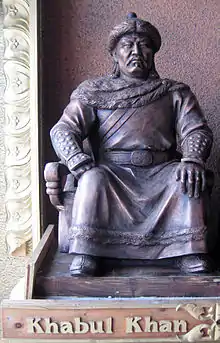Khabul Khan
Khabul Khan, also known as Qabul Khan, Kabul Khan[1] and Khabul Khagan, was the first known Khan of the Khamag Mongol confederation and great-grandfather of Genghis Khan.[2]
| Khabul Khan | |
|---|---|
| Khan of the Khamag Mongol | |
 Statue of Khabul Khan in Mongol Castle | |
| Reign | 1130–1146? |
| Coronation | 1130 in Khuruldai |
| Successor | Ambaghai Khan |
| Issue | Okhinbarkhag Bartan Baghatur Khutugtu Monkhor Hotula Khan Khulan Khadaan Baghatur Todoi |
| House | Borjigin |
| Father | Tumbinai Setsen |
Family and background
Khabul Khan was a son of Tumbinai Setsen and great-grandson of the Khaidu. He was head of the Borjigin clan.[3]
Campaigns
Khabul Khan entered history as a result of his clashes with the Jurchens, a people who lived in Manchuria who later established the Jin dynasty in 1115, and gradually took control over Manchuria. In alliance with the Chinese Song dynasty, they attacked the Liao dynasty, and by 1122 had captured a significant portion of Liao territory.[4] In 1135, Khabul Khan was invited to the court of the Emperor Taizong of Jin, where he famously pulled the emperor’s beard. The Jin army pursued him into southern Mongolia, but Khabul eluded capture and returned with a larger army to pillage the Jin dynasty.[5]
When the Jin army then entered Mongolia with the intention of conquering the territories ruled by the Emperor Dezong of Liao, the founder of the Qara Khitai, or Western Liao dynasty, it was Khabul Khan who put together a Mongol confederation and led the successful effort to repel this invasion.[3]
The confederation was called the Khamag Mongol (or "Whole Mongol") and consisted of the four core clans: Khiyad, Taichuud, Jalairs, and Jirukhen. It is “sometimes…considered a predecessor state” of Genghis Khan’s empire.[6] When the Jurchen accepted their defeat, they recognized Khabul Khan, in 1146 or 1147, as the paramount ruler of the Mongols, although they still “officially considered him their vassal.”[3]
Khabul Khan has been described as having “expanded his Mongol tribe and achieved incredible triumph in suppressing the Tatar tribes,” an accomplishment in which he was aided by his son Yasukai.[7] His activities during his reign marked the first attempts to politically unify the Mongols.[8]
Though Khabul Khan had 7 sons, he nominated Ambaghai, a son of Sengun Bilge from Taichuud clan, as his successor.[5][6]
Descendants and legacy
Khabul Khan had seven sons, the oldest being Okin-barkhakh and the second oldest Bartan the Valiant. Bartan, in turn, fathered Yesugei, the father of Genghis Khan. The Khabul Khan’s third son was Mongler, who fathered Buri the wrestler.[9]
Khabul is considered important today because of his establishment of the Mongol state. He is also considered by some historians to have been a reformer and is described as a promoter of democracy.
See also
References
- Man, John. (2013). Genghis khan : life, death, and resurrection. New York: St. Martin's Press. ISBN 9781466861565. OCLC 872644244.
- Mongolia :: The rise of Genghis Khan – Britannica Online Encyclopedia
- Beckwith, Christopher (16 March 2009). Empires of the Silk Road. Princeton University. ISBN 978-1400829941.
- Biran, Michal (2005). The Empire of the Qara Khitai in Eurasian History: Between China and the Islamic World. Cambridge University.
- Erich Haenisch, Die Geheime Geschichte der Mongolen, Leipzig 1948, p.7 (=section 52)
- Bold, Bat-Ochir (2001). Mongolian nomadic society: a reconstruction of the "medieval" history of Mongolia. Routledge. ISBN 0700711589.
- Udhoke, Sukhpreet (June 19, 2017). "Law of Yaasa under which Guru Arjan Sahib was martyred". LinkedIn.
- Vidakovic, Nenad (30 April 2015). "Early Mongols – the Ethno-Political History to the 13th Century". Migracijske I Etničke Teme. hrcak. 31 (1): 65–114. doi:10.11567/met.31.1.3.
- Waley, Arthur (12 January 2008). The Secret History of the Mongols and Other Pieces. House of Stratus. ISBN 9780755116041.
Khabul Khan | ||
| Regnal titles | ||
|---|---|---|
| Preceded by New creation |
Khan of Khamag Mongol 1120's–1148/1150 |
Succeeded by Ambaghai |